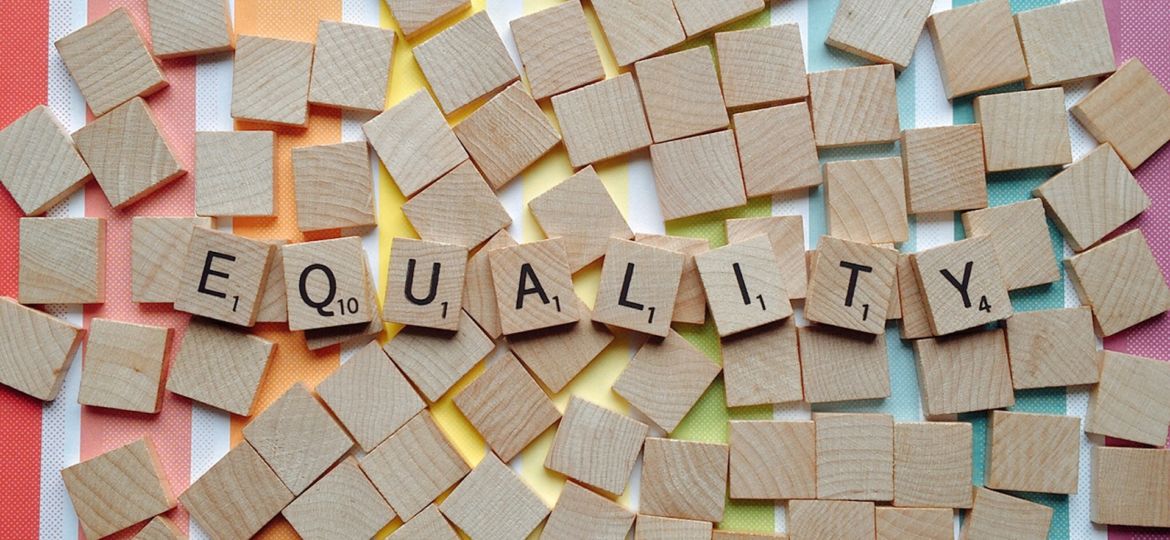
In recent years especially “equality“ has become a buzzword. Many policies incorporate reaching equality as a goal in companies and institutions. Yet what does it actually mean to strive for true equality? Taking a stance on this topic is important to us as Corporate Democrats, since Liberty, Equality & Solidarity are the basic values that democracy is based on.
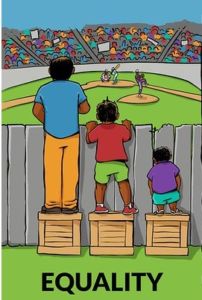
Many people would say something along the lines of “It means to treat everybody equally, regardless of – for example – gender, ethnicity or history and give everybody equal support.” This sounds quite reasonable and noble at first, but essentially equality often looks like this:
Everybody gets one wooden box (Pic 1) to aid them watch the sports game. Everybody is treated the same way. After all, this is what we would usually call “fair”, so surely nobody can complain now anymore to be treated not “equally”. Yet, this definition of equality is based on a relatively low cognitive level; it’s how kids usually see the world. If we however look at the bigger picture, we observe that this constellation doesn’t make much sense.
What makes more sense, of course, is to give more boxes to the kid on the right (PIC 2), so that they can watch the game over the fence too. Now, the person on the left could complain that it’s unfair that they didn’t get any boxes, however how many boxes each person gets is besides the point. The point is to be able to watch the game.
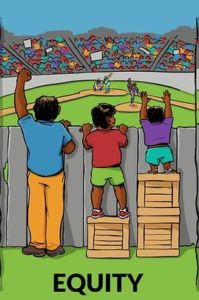
Naturally, this is an oversimplified example. You could argue that often the differences between us are more complex than just height and determining what it is that we want to be fair about (quantity of boxes or watching the game) is more difficult. Our world surely is much more complex. For example, allocating resources and determining salaries in a fair way is such a non-trivial matter that within New Work a whole new term has been developed: New Pay. Despite the picture series’ limited ability to represent the world’s complexity accurately, I like it, as to me it highlights the most important point about true equality (here: equity): it is about enabling people to be who they are and at the same time empowering them to do what they strive to do.
We can argue that the first step to enabling people to be who they are, is by not judging them. However, this is more easily said than done. Judgement often is a result of pre-conceived and socialized prejudice based on centuries of systematic oppression. Therefore, this step towards equity involves addressing personal and systematic biases that have instilled prejudices in us all, regardless of our own gender, race, or other defining characteristics. This step is not simple, nor can it be achieved in a day or without the very hard work of being self-critical.
In a second step, we can embrace our equal value as human beings, while at the same time appreciating and fostering our differences. This gets us much closer to the essence of what true equality means. While formulated in 2 steps, you might have noticed that they are neither trivial nor easy processes. In fact, overcoming our unconscious biases is a lifelong learning process and whenever we face situations where we judge others, we have to remind ourselves of the 2 steps again.
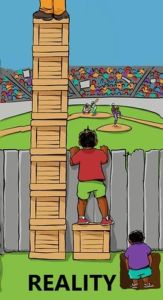
Not surprisingly given its simplicity, the picture has also been criticised on the web. Some criticise that the differences that need to be accommodated for, according to this picture series, are “inherent to the people themselves”. The height as a symbol gives the impression to some that the picture series is only about accommodating for biological differences. According to the author Heidi Schillinger of the blog article “Can we stop using the box graphic when we talk about racial equality?”, this picture series “continues this dangerous narrative that racial equity is ‘helping’ people of color and communities of color because [they] are inherently and biologically deficient.” She continues outlining that it is systematic barriers and not biological differences, which are the reason for people of colour being portrayed as lazy or not as smart.
Compare this with the hole that the shortest person is now standing in PIC3. In reality, systematic barriers in our capitalistic system lead to the already privileged (symbolised by the tallest person in the picture, who can already watch the game anyways) accumulating more and more, which is called the Matthew Effect. Minorities or people who have been historically underprivileged are denied the means they need to stand at an equitable or even equal level as the rest of society.
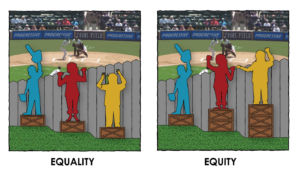
While I agree that it is important not to confuse the short height as a symbol for a shortage inherent to a person or a group of people, I do not think that this picture series is to be taken that literal. One might as well imagine an alternative like PIC4, where there is no height difference and no skin colour. To me, the shortest person in the picture series symbolises a specific support needed at a specific moment or period of time, where the support is very dependent on the individual and the situation. The symbolic situation in the picture series may apply to groups of people or individuals; to instants in time or longer periods. It basically states “Let’s direct support/ means/ resources to the person/ people who, in a utilitarian sense, have the most to gain [so that everybody can watch the game]”. Given our collective history of systematic oppression, this may start by allocating resources to those people not born with privilege, allowing them to reach the same height as others as a result of their status in society.
Only if we let our biases (with regard to race, gender identity or expression, or any other protected class) overshadow the key principle that all human beings are of equal worth, do we make conclusions such as the height in the pictures indicating some shortage inherent to a person or group of people. Therefore I agree with Heidi Schillinger that “racial equity is about eliminating racism”, since we cannot have any equity if our actions and interpretations are based on systematic biases. Racism is just an example I picked here, but this can be generalised to all kinds or preconceptions about a group of people or individuals.
Our world today is so complex that we can always feel treated unfairly in some way or the other, so we must remind ourselves whether we want the boxes for the sake of the boxes, for some other reason (for example, there is money in the boxes and money gives security) or to be able to watch the game. At the end of the day, it doesn’t matter what analogy we use, and how much we try to improve the picture series in order to get rid of elements that could be interpreted the wrong way. What counts is our attitude towards people, our willingness to question our individual and collective biases and adapt our world views as a result. Only if we understand that we are all of equal worth, that we are all interconnected and that there is a huge value in our differences, then we know how to allocate resources to empower people in the most meaningful way.
All the best,
Julia
Acknowledgements
I would like to thank Keira Brooks for her input to make this article better at addressing privileged and underprivileged people equally. I feel that equality is a very delicate topic nowadays and one has to be careful not to offend anybody. Given how passionate Keira is about this matter and how tirelessly she fights against sexism, her comments mean a lot to me and I appreciate the time she spent on them. Although I was glad that she didn’t have to disrupt my whole article, her perspective was important to make me aware of my own biases :).
Picture Credits
- Article Pic: pixabay, public domain
- Pic 1-3: ©Interaction Institute for Social Change | Artist: Angus Maguire, free to use
- Pic 4: ©Cultural Organizing

